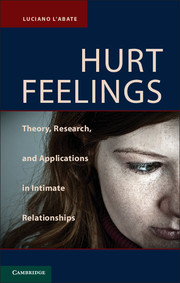Book contents
- Frontmatter
- Contents
- Preface
- Acknowledgments
- Introduction
- Part One Background
- Part Two The Scientific Bases of Hurt Feelings
- 6 The Discovery of Hurt Feelings
- 7 Biological Processes Underlying Hurt Feelings
- 8 Gender and Individual Differences in Hurt Feelings
- 9 Cultural Differences in Hurt Feelings
- 10 The Psychopathology of Hurt Feelings
- Part Three Applications of Hurt Feelings in Mental Health
- Part Four Models of Hurt Feelings In Theory and Applications
- Appendix A An Informed Consent Form to Deal with Hurt Feelings
- Appendix B Experimental Scale of Unexpressed Hurt Feelings
- References
- Author Index
- Subject Index
10 - The Psychopathology of Hurt Feelings
Influences on Physical and Mental Health
from Part Two - The Scientific Bases of Hurt Feelings
Published online by Cambridge University Press: 05 June 2012
- Frontmatter
- Contents
- Preface
- Acknowledgments
- Introduction
- Part One Background
- Part Two The Scientific Bases of Hurt Feelings
- 6 The Discovery of Hurt Feelings
- 7 Biological Processes Underlying Hurt Feelings
- 8 Gender and Individual Differences in Hurt Feelings
- 9 Cultural Differences in Hurt Feelings
- 10 The Psychopathology of Hurt Feelings
- Part Three Applications of Hurt Feelings in Mental Health
- Part Four Models of Hurt Feelings In Theory and Applications
- Appendix A An Informed Consent Form to Deal with Hurt Feelings
- Appendix B Experimental Scale of Unexpressed Hurt Feelings
- References
- Author Index
- Subject Index
Summary
[A] catastrophic illness does one of two things. It either makes you bitter or makes you grateful. It made me grateful, especially for my family and my friends and colleagues. (Marguita Lister as quoted by Eisenberg, 2009).
The purpose of this chapter is to show that the whole organism will suffer when presumed hurt feelings are produced by repeated, traumatic, aversive, painful, or objectively or negatively perceived circumstances or events. Even more specifically, presumed hurt feelings per se do not produce personal and relational dysfunctionalities. The avoidance of expressing them and the lower ratio of sharing joyful and pleasant experiences to hurt feelings is what causes those internal and relational dysfunctionalities. However, there is a growing concern in the United States about avoidable, unjust differences in health associated with sociodemographic characteristics, such as socioeconomic status (SES) and race/ethnicity. This concern has sparked research to identify how disparities develop and how they can be reduced. Studies that show that disparities occur at all levels of SES, not simply at the very bottom, suggest that psychosocial factors play an important role (Geronimus, Colen, Shochet, Ingber, & James, 2006; Geronimus, Hicken, Keene, & Bound, 2006). Therefore, this chapter will consider how presumed hurt feelings are present and influential in physical illness, in severe psychopathology (Axis I of the DSM-V), and in personality disorders (Axis II of the DSM-V), as well as in the population at large. These feelings constitute, therefore, the so-called unconscious (Bargh et al. 2008; De Giacomo et al., 2010).
- Type
- Chapter
- Information
- Hurt FeelingsTheory, Research, and Applications in Intimate Relationships, pp. 214 - 240Publisher: Cambridge University PressPrint publication year: 2011



